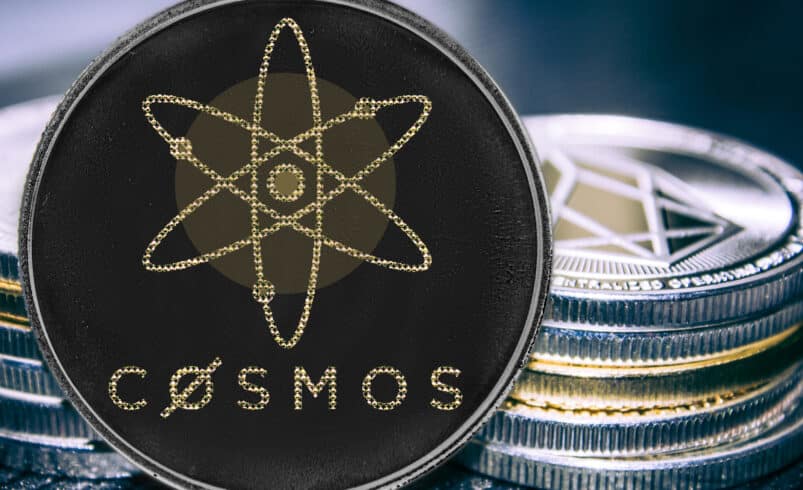Cosmos Unveiled: A Beginner’s Guide to the ‘Internet of Blockchains

In today’s digital landscape, interoperability stands as a central pillar. Without it, Gmail couldn’t chat with Hotmail, and your Android phone would never ‘talk’ to Apple’s iOS. However, the question of interoperability only applies to email and phones.
Cosmos has pioneered this concept within the crypto realm, bridging the gap between multiple blockchain networks. Consequently, let’s delve deeper into Cosmos, its workings, and its significance in today’s crypto ecosystem.
Unraveling the Magic: How Cosmos Operates
Cosmos, often dubbed the ‘Internet of Blockchains,’ is not just another blockchain. It’s an intricate network designed to streamline communication between diverse blockchains. Think about how seamlessly an email from Gmail reaches a Yahoo inbox. That’s interoperability, and in the blockchain realm, Cosmos has mastered it.
At its heart, Cosmos relies on hubs and zones. The central hub, called the Cosmos Hub, is pivotal. However, it doesn’t lord over the other zones since they can function independently and establish seats. These zones, unlike traditional smart contracts, are sovereign blockchains.
Consequently, each has unique rules, operations, and functionalities. However, they are all unified in their ability to communicate effortlessly, thanks to the Inter-Blockchain Communication (IBC) protocol.
Moreover, Cosmos isn’t limited to its native environment. It interacts with stalwarts like Bitcoin and Ethereum through innovative bridges, bringing them into its interoperable fold.
The foundation of Cosmos is the Tendermint Byzantine fault tolerance (BFT), a consensus algorithm that not only secures the network but simplifies the development process. Developers no longer need to start from scratch. Instead, they utilize this engine to create customized blockchains. Furthermore, the Cosmos software development kit (SDK) further amplifies this simplicity, enabling faster and more cost-effective blockchain development.
Why Does Cosmos Matter?
The brilliance of Cosmos lies in its solutions to three core challenges in the blockchain sphere: sovereignty, scalability, and sustainability.
Sovereignty: Cosmos offers developers a platform to create individual blockchain apps without continuous expenses. These sovereign blockchains can interact with one another without being shackled by prohibitive fees or scalability issues. This move enhances functionalities in various sectors, from decentralized finance to gaming.
Scalability: With its innovative architecture, Cosmos ensures scalability. Blockchains can communicate effortlessly, evolving collectively by adopting shared communication standards. Additionally, Cosmos offers solutions like cloning blockchains to reduce congestion or dividing applications into distinct blockchains, which then operate in a harmonious network.
Sustainability: Unlike the energy-intensive proof-of-work (PoW) consensus algorithm, Cosmos employs proof-of-stake (PoS). This step not only ensures network security but drastically reduces its carbon footprint.
Cosmos vs. Its Contemporaries
In the realm of blockchains, Ethereum has long been a giant. However, where Ethereum struggles with scalability and still relies on the PoW consensus, Cosmos shines with its Tendermint BFT and PoS algorithms. This move gives Cosmos an edge in transaction speed and cost-efficiency.
Another notable competitor is Polkadot. While both aim for blockchain interoperability, their approaches differ. In Cosmos, the autonomy of each blockchain is preserved. In contrast, Polkadot’s parachains share a unified security protocol.
Steering Cosmos: The Brains Behind It
Cosmos is the brainchild of Jae Kwon and Ethan Buchman. Founded in 2014, it blossomed under the joint efforts of the Swiss Interchain Foundation and the Tendermint team. These entities channeled funds and resources, driving its growth. Today, Ethan Buchman is president of the Interchain Foundation Council, continuously steering Cosmos toward innovation.
Investment Potential and Beyond
Since its inception, Cosmos’s native token, ATOM, has witnessed significant growth, touching an all-time high of $38.78 in September 2021. As more zones integrate into the Cosmos ecosystem, ATOM’s value as the linchpin currency is set to soar. For potential investors, it’s paramount to understand that ATOM doesn’t have a capped supply. Instead, its creation is adjusted based on staking activities.
Furthermore, staking ATOM holds dual benefits: earning rewards and influencing network decisions. Staking contributes to the ecosystem’s security and governance and offers returns averaging 9.7% annually.
Looking ahead, the horizon for Cosmos is radiant. Enhanced security measures, fluid IBC connections, and expansive cross-chain functionalities are just a few items on its roadmap. With its dedicated team and innovative spirit, Cosmos is poised to shape the future of blockchains.
Hence, as we navigate this blockchain universe, Cosmos, with its seamless interoperability and robust features, is undoubtedly a beacon of innovation worth watching.
DISCLAIMER: It's essential to understand that the content on this page is not meant to serve as, nor should it be construed as, advice in legal, tax, investment, financial, or any other professional context. You should only invest an amount that you are prepared to lose, and it's advisable to consult with an independent financial expert if you're uncertain. For additional details, please review the terms of service, as well as the help and support sections offered by the provider or promoter. While our website strives for precise and impartial journalism, please be aware that market conditions can shift unexpectedly and some (not all) of the posts on this website are paid or sponsored posts.









